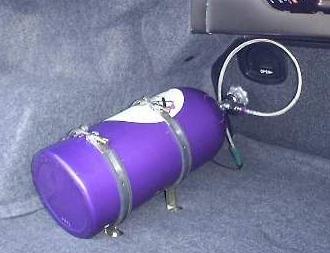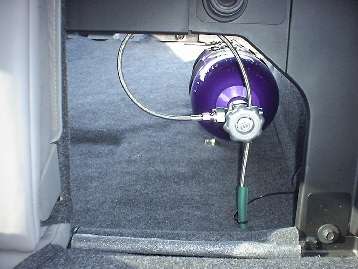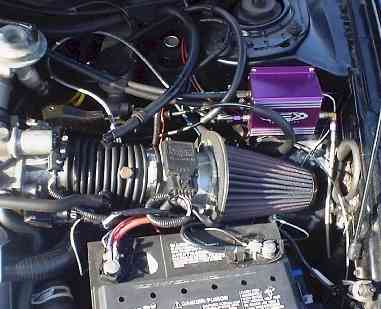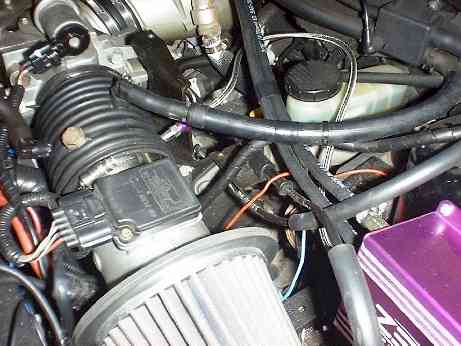| In
a joint venture with my fellow V8 SHO enthusiast, Scott Waters, we
explored the possibility of installing nitrous oxide kits in our 1996
SHO’s. Inevitably, we purchased and installed 75 HP Zex nitrous
systems on our cars. So far,
zero problems with detonation or any other signs of failure.
Scott and I also run with the exhaust disconnected (at the track)
which makes for an absolutely thunderous ride.
(If you've never heard an uncorked V8, there's a file posted on my
website, listed below.) The
lack of low-end torque from the open exhaust and the new Dunlop 8000's
produced only a sparse chirp on launching but there was abundant torque
steer. Getting the car to hook up at the drag strip is another story.
Having a free flowing exhaust is important when running a nitrous
setup, but if it’s too free flowing, performance can be hurt.
My best time, on street tires, is 14.39 @ 96.87 mph.
I feel that the lack of backpressure from the open exhaust is
hurting the car's performance while running nitrous.
I'll be searching for some sort of exhaust setup that will be free
flowing, yet provide a slight amount of backpressure.
Scott’s car runs 13.8 @ 102 mph at the track, but then again, he
has a UDP and drag slicks. I’ll
be gunning for Scott next year! |
 |
Notice the bright purple bottle. It's enough to make
you giggly inside!!!
The kit comes with
everything you need: the 10 lb. bottle, mounting brackets, braided
stainless steel line, Zex's Nitrous Management Unit, 55,65, and 75 HP
jets, the remote arming switch, wiring and connectors, vacuum hoses and
clamps and all necessary hardware. You will need to buy about 5' of
3/32" vacuum hose, though. (The hose supplied is too short to
reach the FPR on our cars.) |
To
answer the question as to whether nitrous setups are dangerous: Yes . . .
and No. Yes, if you don't
know what you are doing, or if you are a moron and forget to turn off the
electric bottle warmer (from a friend on the Maxima list who knew a person
who blew up his trunk because of this.)
No, it's not dangerous if you know how nitrous makes HP and how to
apply it. Research and
knowledge is the key to making a modification such as nitrous.
This is what Scott Waters and I did.
We learned about the modification by speaking with others who have
installed nitrous (Randy Mercante via Doug Lewis, primarily,) and we took
the next step. From speaking
with Randy and Doug, we knew Randy's car was running a dry nitrous setup.
They had already done this up to the 120 - 150 HP level.
A dry setup is one that injects a determined amount of nitrous into
the intake tract, before the TB. A
wet system introduces both fuel and nitrous either into the intake tract
or into each cylinder directly. The
problem with a wet system is that the mixture can pool and be detonated by
the heat INSIDE the intake plenum and not in the cylinder.
This causes the spectacular hood removals that some may have seen.
So, we knew we wanted a dry nitrous system.
Nitrous: The Basics
Here’s a little bit on how nitrous
works. Nitrous Oxide (N2O) is comprised of two parts nitrogen and one part
oxygen; 36% oxygen by weight. This
mixture is much more saturated in oxygen than the air we breathe, which
makes it a benefit to use on cars. Nitrous
is very cold and in gas form at room temperature.
Nitrous is injected through the intake into the combustion chamber,
(by simple bottle pressure at 900psi.)
During the combustion process in an engine, at about 572 degrees F,
nitrous breaks down and releases oxygen.
(An added bonus is that the nitrous is so cold, that it can reduce
intake temperatures up to 75 degrees; as we know, cold dense air = better
power.) This extra oxygen
creates additional power by allowing more fuel to be burned. The Nitrogen acts to buffer, or dampen the increased cylinder
pressures helping to control the combustion process. Nitrous isn't the dangerous part of the equation, the added
fuel is. If the added fuel
doesn't have the added oxygen to match (i.e., when there is low pressure
in the bottle or if the nitrous solenoid fails), the car goes instantly
rich which can lead to detonation or worse.
If the fuel pressure isn't increased, then the car is instantly
lean. It's a balancing act.
So, the second component of any nitrous setup is adding the correct
amount of fuel in proportion to the nitrous that is injected.
How do we do that without big bucks? |
| Here is a good shot from the cabin showing the bottle
valve and the Nitrous line running through the trunk floor. Now
all he needs is a back seat companion to turn it on! |
 |
| Now
Randy and Doug went all out by getting a dual mode chip, an MSD ignition
setup (to control timing retard) and dual stage, progressive nitrous
controller so he wouldn't smoke the tires, a larger fuel pump and
injectors, and beefed up the tranny.
I couldn't afford that route and wanted to maintain the drivability
of the car while being concerned for the durability of the stock tranny.
We still needed to solve the fuel pressure issue and still address
the timing retard issue, which I am just mentioning now.
Timing was easy, since the V8's knock sensors would adjust +/- 2
degrees automatically for lean/rich conditions over stock.
(Timing has to be adjusted 1 to 1.5 degrees for every 50-75 HP of
nitrous.) Without a dual chip
and a secondary ignition setup, this would limit our nitrous application
to the sub 100 HP level. That
was fine because we felt the tranny would need to be beefed up at that
level. With the
car adjusting timing automatically, that issue shortly became moot.
But adding fuel still was still a problem.
Another concern was the platinum spark
plugs. Without getting too
deep into this issue, the plugs have to be switched to the standard copper
instead of platinum. I
prescribe to this for two reasons: First,
if a failure were to occur, for whatever reason (most likely an over-rich
condition) you WANT a plug to fail. Why?
Because it is much easier and cheaper to replace than a pistons or
rings or something far scarier. So
by making the plug the weak link, your worst nightmare will be that you
foul a plug. Yeah, it's a
pain to change the back bank, but it's better than changing a bent rod or
piston rings. So, I thank
fellow NESHOC’er Al Primm for guiding me through my plug change.
The second reason you need to switch to copper plugs is that the
intense combustion chamber heat can cause the platinum coating to flake
off. That’s a no-no as
well. The stock plug on the
V8 SHO is AWSF32P (or PP, P+) for platinum.
The copper plug to use is the standard Ford AWSF22C. The “22” simply means that the plug has a colder heat
range and the “C” is for copper.
The stock gap of .042 to .046 works well. |
 |
Note
the purple "box" mounted on the driver's side strut tower. This
is Zex's unique Nitrous Management Unit. Bottle pressure is fed into
the unit and distributes nitrous to the intake (between the MAF and the
TB) and to the FPR. This is probably the only place you can mount
the NMU. |
| OK,
that's nitrous in a nutshell. So
Scott and I were looking for something that would give us a little kick,
not break the bank, have a low probability of failure, and adjust the fuel
pressure automatically (which we still haven’t addressed yet.)
I credit Scott with doing the research and finding the right
product that fit our needs. Introduce
ZEX Nitrous Systems, a division of Comp Cams . . .
The system is designed for the import
crowd . . . Honda, Toyota, etc. but it seemed that it would adapt
remarkably well to our needs. The
kit is self-regulating and adjusts fuel pressure according to bottle
pressure. The system is
activated off the TPS, which means there are no throttle switch brackets
to rig up. The Zex Nitrous
Management Unit monitors the TPS voltage.
When that voltage increased to 4.6, the car is at WOT and the
nitrous is injected. You want
the nitrous to kick in at WOT because that’s when the most fuel is being
added. When you let off the throttle, and the voltage dropped below
4.6, the nitrous was shut off. A
unique part of the system is that the Nitrous Management Unit taps into
the FPR by means of vacuum tubes to increase fuel pressure.
The system works off of a manifold in the Nitrous Management Unit
and is controlled by metering jets, similar to carburetor jets.
One jet is installed inline with the nozzle that is plumbed into
the intake before the TB. The
other jet whose size is in direct correlation to the selected nitrous jet,
controls the fuel pressure and is installed inline with the FPR vacuum
plumbing. On the V8 SHO,
there is only one FPR on a single fuel rail.
(Note: The V6
SHO’s have dual rails and two FPR’s, so this kit would probably not
work well on the Gen I & II cars.)
The stock FPR has a small vacuum hose that runs between the FPR and
the intake manifold. On a
stock system, as added pressure is built within the manifold, pressure is
exerted on the FPR's diaphragm to add more fuel.
With the ZEX control unit, a metered amount of nitrous is injected
to the FPR to add fuel pressure. |
| If you look closely you will see the braided stainless
steel line that goes into the rubber tube connecting the MAF and the
throttle body. This is the nitrous spray nozzle, containing the
nitrous jet. |
 |
| So
briefly, there is a master-arming switch in the cabin that turns the whole
system on. When you romp on
the throttle, the unit senses 4.6 volts that is generated at WOT and opens
the manifold for the nitrous. The
10 lb. bottle, mounted in the trunk feeds the nitrous over a braided SS
line to the engine bay where the control unit is mounted on the driver's
strut tower. The manifold inside the control unit delivers nitrous to the
car's intake manifold and to the FPR.
This gives you the proper nitrous and fuel mixture and you are off
to the races. When you back
off the throttle, the voltage drops and the nitrous to the intake and to
the FPR are cut. You look in
your rear view mirror at the ponycar 4 to 5 car lengths behind you . . .
and you smile . . . “Life is good.” |




